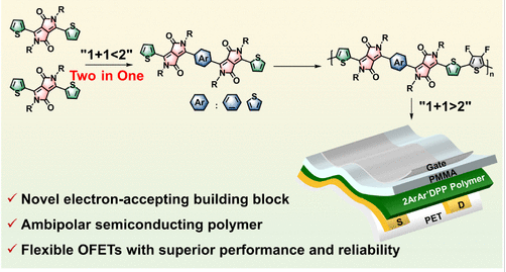
近日,兰州大学刘子桐团队研究了柔性晶体管中双极性共轭聚合物的“二合一”DPP构建块。相关论文于2025年5月14日发表在《美国化学会杂志》上。
具有优异半导体性能和可靠性的共轭供体-受体(D-A)聚合物的进步对柔性电子器件的发展至关重要。然而,电子受体构建块的发展远远落后于电子供体构建块,阻碍了双极性和n型半导体聚合物(尤其是双极性类型)的发展,从而限制了逻辑电路和p-n异质结的构建。在这项研究中,课题组介绍了一种新的电子受体构建块2Ar'Ar2DPP,它经过精心设计,适用于为柔性电子应用量身定制的半导体聚合物。
通过改性常规二酮吡咯并吡咯(DPP)合成2Ar'Ar2DPP─包括2TPh2DPP和3T2DPP─将具有两个芳香基团的单个DPP单元合并为具有两个DPP单元和三个芳族基团的配置。这种修饰增强了电子接受能力,并调节了分子内和分子间的D-A相互作用。对2TPh2DPP和3T2DPP进行了研究,以探索它们的结构-性能关系。
具体来说,3T2DPP表现出改善的骨架平面性、扩展的π共轭和更有效的分子内D-A相互作用。与常规使用的噻吩侧翼DPP甚至其二聚体相比,这些特征导致LUMO水平显著降低,带隙变窄。此外,3T2DPP分子结构对称性的变化诱导了相对较大的偶极矩,从而增强了分子间的相互作用。因此,衍生自2Ar'Ar2DPP的聚合物在柔性有机场效应晶体管中表现出双极半导体性能,分别实现了高达6.0和2.1 cm2 V–1 s–1的空穴和电子迁移率,具有良好的抗弯性。这些初步结果表明,2Ar'Ar2DPP对未来柔性电子共轭材料的设计具有重要前景。
附:英文原文
Title: “Two-in-One” DPP Building Blocks for Ambipolar Conjugated Polymers in Flexible Transistors
Author: Bolun Huang, Pinyu Chen, Xinqiang Hua, Dongsheng Qiu, Tianqiang Cui, Jiulong Zhang, Shuxian Zhang, Cheng-Shan Yuan, Feng He, Xiangfeng Shao, Hao-Li Zhang, Zitong Liu
Issue&Volume: May 14, 2025
Abstract: Advancements in conjugated donor–acceptor (D–A) polymers with superior semiconducting performance and reliability are pivotal to the evolution of flexible electronics. However, the development of electron-accepting building blocks has lagged far behind that of electron-donating ones, hindering the progression of ambipolar and n-type semiconductor polymers―especially ambipolar types―and thereby limiting the construction of logic circuits and p–n heterojunctions. In this study, we introduce a new electron-accepting building block, 2Ar’Ar2DPP, meticulously engineered for semiconducting polymers tailored to flexible electronics applications. Synthesized through the modification of conventional diketopyrrolopyrrole (DPP), 2Ar’Ar2DPP─including 2TPh2DPP and 3T2DPP─incorporates structural innovations, merging a single DPP unit with two aromatic groups into a configuration featuring two DPP units and three aromatic groups. This modification enhances the electron-accepting ability and modulates intra- and intermolecular D–A interactions. 2TPh2DPP and 3T2DPP were investigated to explore their structure–property relationships. Specifically, 3T2DPP demonstrates improved backbone planarity, extended π-conjugation, and more efficient intramolecular D–A interactions. These features result in significantly lower LUMO levels and narrower band gaps compared to those of conventionally utilized thiophene-flanked DPP and even its dimer. Moreover, the change in the molecular structural symmetry of 3T2DPP induces a relatively large dipole moment, thereby enhancing intermolecular interactions. Consequently, polymers derived from 2Ar’Ar2DPP exhibit ambipolar semiconducting performance in flexible organic field-effect transistors, achieving hole and electron mobilities of up to 6.0 and 2.1 cm2 V–1 s–1, respectively, with good bending resistance. These preliminary results indicate that 2Ar’Ar2DPP holds significant promise for the future design of conjugated materials for flexible electronics.
DOI: 10.1021/jacs.5c03046
Source: https://pubs.acs.org/doi/abs/10.1021/jacs.5c03046
JACS:《美国化学会志》,创刊于1879年。隶属于美国化学会,最新IF:16.383
官方网址:https://pubs.acs.org/journal/jacsat
投稿链接:https://acsparagonplus.acs.org/psweb/loginForm?code=1000
